This post may contain affiliate links. If you make a purchase through a link, I may receive a small commission, at no cost to you. These commissions help keep this website up and running, and I thank you for your support. Read my full disclosure here.
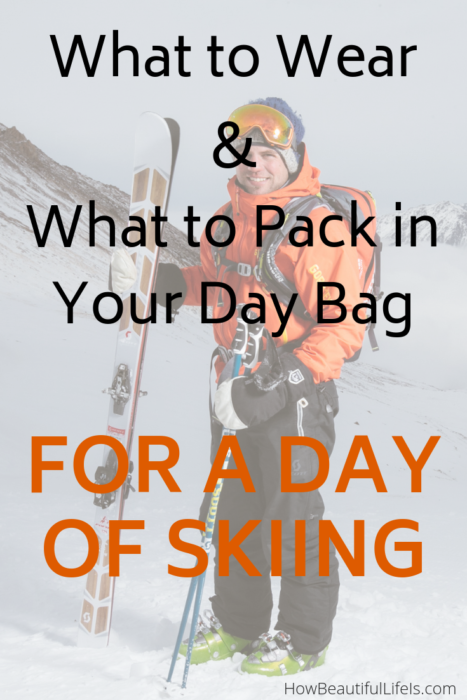
Planning a day out on the slopes for the first time? This guide will provide you with a list of essential ski clothing and ski gear that you need to take, as well as what to pack in your day bag for a day of skiing. Try not to pack more than you need, because you don’t want to be unnecessarily carrying around a heavy bag all day. Also, if it is too bulky, then you will need to wear it to the front of you when getting on the chair lift (as it can stop you from properly sitting back in the chair – you don’t want to fall off!) which will be annoying to do all day.
What to Pack in Your Day Bag for a Day of Skiing
A good quality, comfortable day pack is essential for skiing so you can stash your supplies. Go for a small bag like this one because otherwise you will need to place it in front of you every time you get on the chair lift which will be annoying.
Stainless Steel Drink Bottle
Make sure you pack a water bottle to stay hydrated on the slopes. I love this stainless steel drink bottle as I am trying to cut down on my use of plastics. This bottle is leak proof and insulated so keeps hot water hot and cold water cold.
Toiletries
Sunscreen and Lip Balm with Sunscreen
Avoid an embarrassing goggles tan by wearing sunscreen. As I mentioned above, the snow is highly reflective of ultraviolet radiation so you need to use a strong sunscreen. When choosing your sunscreen, it’s essential that it is broad spectrum and protects against both UVA and UVB. I use Neutrogena Ultra Sheer Dry-Touch because even though this is a heavy duty sunscreen, it’s not oily or messy, and I like that it doesn’t have a strong fragrance. Read my post on My Favourite Sunscreens for Face and Body.
Don’t forget your lips! When it comes to sun protection, I use Banana Boat chapstick because it provides moisture as well as good broad spectrum sun coverage and it is water resistant.
Pain Relief
As a beginner you are likely to take some tumbles on the slopes. When its icy you can really end up with some bruises! Take some anti-inflammatory’s with you to ease the pain.
Tissues
I always stash lots of pocket tissue packs in my pockets, particularly on the cold slopes where exercise combined with the cold weather really makes my nose run. Also, sometimes the toilet paper runs out in the toilets.
Inhaler
If you are asthmatic, don’t forget to pack your inhaler.
Food
Food is expensive in the ski field restaurants, so if you want to save money and avoid the queues, then pack your own lunch and snacks. There is usually picnic seating outside and inside. Pack nutritious snacks, you will be doing lots of exercise, so don’t forget to refuel your body.
Electronics
Portable Battery Charger
Unfortunately most electronics like smart phones have a really short battery life and can become flat before the end of the day. That’s why this portable battery charger is an essential item when you’re travelling. It can charge your phone, tablet, and any other USB chargeable device.
Tip
- To stop your phone battery from running down whilst you are not using it, put it in airplane mode.
Compact Camera
A small, light camera that enables you to take high quality photos and videos of your ski trip is a must. This Canon compact camera features 20.3 MP, 40x zoom with image stabilizer, wide angle lens and 4K video. It even includes built in Wifi that allows you to use your smartphone or tablet to remotely control the camera. Don’t forget to purchase a quality SD card that has the capacity for all your photos and videos as well as being fast enough capture full 4K video.
Additional Items
Bus Timetable and Bus Pass
If you are taking a bus out to the ski field, then make sure you have your bus pass with you (if needed) and a bus timetable so you can plan your time time around the bus schedule.
Ski Trail Map
The ski field should have signposts telling you where each trail is and what grade they are, however, it is really helpful having a map of the ski trails. This will help you plan where you are going and what lift to take. It will also ensure you don’t accidentally find yourself on a trail above your abilities. You should be able to pick one of these up from the ski fields Information Centre or print one from the ski field’s website.
Ski pass
Don’t forget your electronic ski pass and to place it in your pocket for easy access getting through the electronic gate.
Cash
Some of the bars on the mountains only do cash for quick service, or there may be a problem with them getting a connection to use electronic payments, so if you are planning on eating out on the mountain, take some cash just in case.
Optional Items
Reading Material
If you don’t think you will ski as long as your companions, then bring a small book or magazine to read in the warmth of the ski lodge.
Light Shoes
If you have to walk a long way to your accommodation from the bus stop, then you might want to pack some small light shoes with you so you can more easily walk. The trade off will be having to carry your boots, so work out which is easier for you to manage.
Ski Gear
Ski Jacket
Wear an insulated ski jacket like this one with hidden ventilation for the warmer days and a wrist pocket to put your ski pass in.
Tip
- It is handy if your jacket has a pocket on the arm to store your electronic ski pass. The ski pass will work through the coat pocket as you pass through the electronic gate, so you won’t need to take it out each time you get on the chair lift. However, if there is no pocket on the arm of the jacket, you can still make do with just using the normal normal pockets, you might just have to lift your jacket up a little to reach the scanner.
Ski Pants
A pair of warm windproof waterproof ski pants are an essential part of your kit. If you try and go skiing without ski pants, your trousers will get wet, especially as a beginner as you will likely fall over a lot, and it will make you incredibly cold!
Tip
- Wear a pair of thermal leggings under your ski pants to keep you toasty and warm.
Ski Gloves
There is nothing worse that having wet gloves, it will make you very cold, so make sure you are wearing some waterproof ski gloves. They may not be pretty, but the key is to keep warm and dry.
Warm Hat
Your hat needs to be firm fitting so it doesn’t fly off whilst you are whizzing down the ski slopes or up high on the chair lift. That’s why beanies are so popular on the ski field. Wear a warm wool hat like this one which has additional fleece lining for extra warmth and for comfort as it your head getting itchy from the wool.
For warmer, sunny days on the slopes, try a headband like this synthetic lined warm knitted headband. It’s stylish and perfect for keeping your ears toasty warm and hair out of your face. They are great for covering up messy hair as well.
Neck Gaiter
A neck gaiter or ‘buff’ is a closed tube of fabric that slips over your head to keep your neck warm. I prefer a neck gaiter made of warm fleece. When it’s really cold you can extend it up over your face. Another benefit is that unlike a scarf it is not as bulky so you can easily zip your jacket up with it underneath and it also won’t come unravelled and flap around. If you don’t want to invest in a neck gaiter and already have a warm infinity or cowl scarf, then you could use that.
Sports Bra
Ladies that need it – don’t forget to pack a good supportive, comfortable sports bra.
Thermals
Warm thermal tops and leggings are essential. My favourite wool thermals are from Ice Breaker – see me in my Ice Breakers thermals in the picture below. Full disclosure – they are a New Zealand brand so as a Kiwi I admit that I may be biased, but I think New Zealand merino wool is the best quality! They come in various weights for different levels of warmth, and unlike the polyester thermals, merino is both breathable and naturally anti-bacterial, it cleverly neutralises odour so you can get away with wearing them over many days without them getting stinky. The merino wool fibres are very fine, so they are softer and more flexible than standard wool, so don’t cause skin to itch. Ice Breaker also sell wool underwear, wool t-shirts (great when the weather is changeable), and outer layers like wool jumpers and hoodies. However, if you can’t wear wool, then skip down to my non-wool alternatives.
Thermal Tops & Singlets
I recommend you buy at least one long sleeve wool thermal like this one. If you really feel the cold like me, then wear a wool singlet underneath it too. A wool singlet won’t create further bulk around the arms (when you wear too many layers it can be hard to bend your arms!), but will add warmth to your core. A wool singlet won’t create further bulk around the arms (when you wear too many layers it can be hard to bend your arms!), but will add warmth to your core.
Thermal Leggings
Thermal leggings are essential for keeping your legs warm under your ski pants. I recommend these mid-weight wool thermal leggings, but if you really feel the cold, you might want to buy the heavyweight wool thermal leggings instead. If you are on a tight budget, then you could consider purchasing some cheaper 400 denier thick pantyhose.
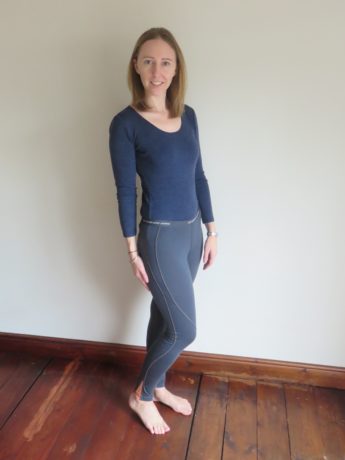
Non-Wool Thermal Alternatives
I don’t recommend cotton thermals, as they have a tendency to retain perspiration which can make you feel cold. If you cannot wear wool then try the Thermasilk range made of 100% silk. Although I haven’t tried them myself, they come highly recommended. They have a wide range of thermals including leggings, tops, socks and gloves. If you don’t wear animal products, then go for a good quality synthetic like this thermal set.
T-shirt
If it’s a warm day, and/or you have a very warm jacket, you may want to strip down to t-shirt underneath it or a t-shirt over your thermal.
Ski Socks
Ski socks are thicker and longer than your usual socks as they are designed to keep your feet and lower legs warm and comfortable as they will be in ski boots all day long. They should also be firm enough to stay up all day and not slide down and bunch up which will cause pressure points and blisters. I prefer these ski socks with wool to ensure warmth and to reduce the stink – you can save money by wearing the same pair several times. If you don’t wear wool, then here are some highly rated non-wool ski socks.
Mid Layers
On top of your thermals, you need to add more layers to keep you warm. Layers will allow you to stay comfortable as you can remove them when you get hot and add more when you get cold. Again, I love the Icebreaker mid-layers, especially the half zip or full zip with the neck collar because as I get hot I pull down the zip and collar to let in some cool air, but then when it gets chilly I can zip up and stay toasty warm. I like to pack an extra mid-layer in my day pack in case it gets really cold. For a non-wool version, go for a nice warm synthetic fleece.
Sunglasses and Ski Goggles
Eye protection is an absolute essential on the ski field because snow is highly reflective of ultraviolet radiation. In fact, snow can reflect more than 80 percent of the UV rays that fall upon it. In addition, skiing takes place at relatively high altitudes, where the sun’s UV rays are stronger. When it comes to what to wear whilst skiing, you have two options for eye protection, either ski goggles or a good pair of sunglasses. Aim for a set of ski goggles like these that are anti-fog and have 100% UV protective lenses, or you could borrow some. Alternatively, a large pair of sunglasses will also suffice, however, they must provide 100% UV protection or UV 400 protection. That means that the glasses protect your eyes from both UVA and UVB radiation. Check the laws for your country, for example, in Australia and New Zealand all sunglasses sold must be tested and clearly labelled according to the Australian/New Zealand Standard for Sunglasses and Fashion Spectacles AS/NZS 1067. I do find that metal rimmed glasses can get really cold, so go for plastic if you can. I also prefer polarised sunglasses for better vision.
Make sure you pack some sunnies in your day pack for when your chilling at lunch time, because wearing goggles whilst eating isn’t very comfortable.
Ski Equipment
Skis/Snowboard, Bindings, Ski Poles, Ski Boots, and Helmet
If you are skiing you will need your helmet, boots, bindings, skis, and ski poles (ski poles are not usually given to kids because they don’t really need them). If you are snowboarding then make sure you have your snowboard, boots, bindings, helmet, a leg leash (in some places this is mandatory) and wrist guards.



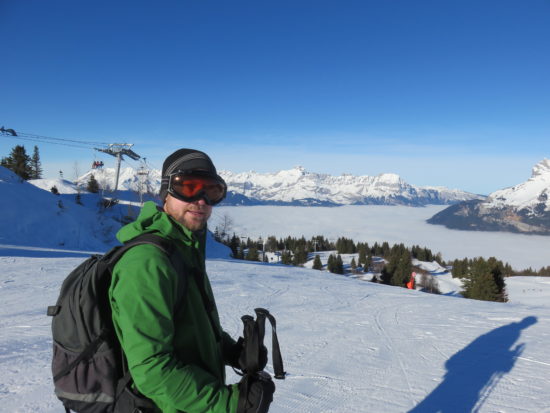





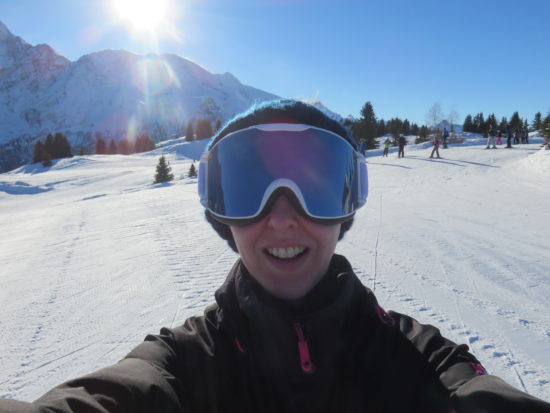

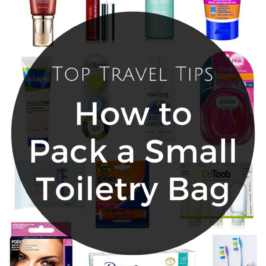
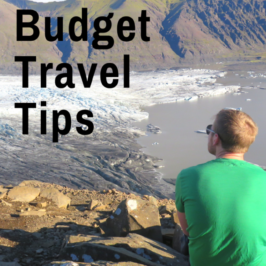


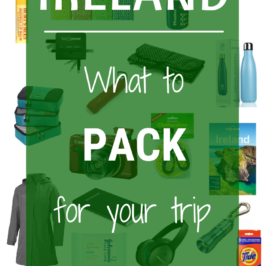
Leave a Reply